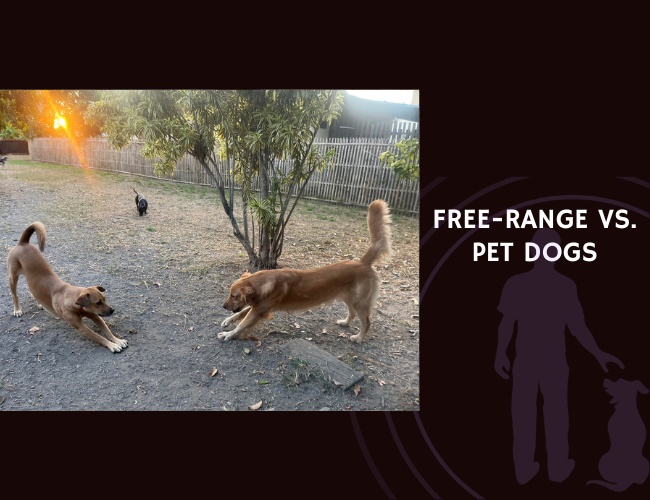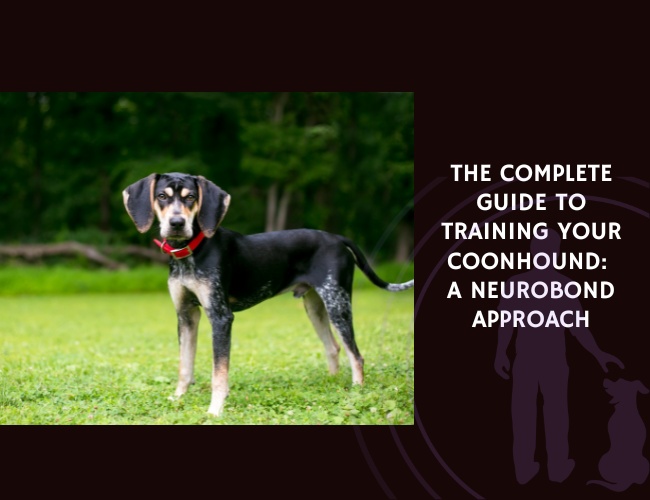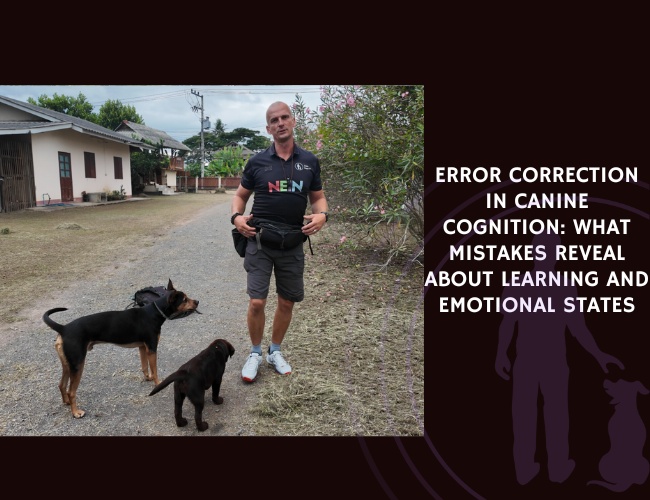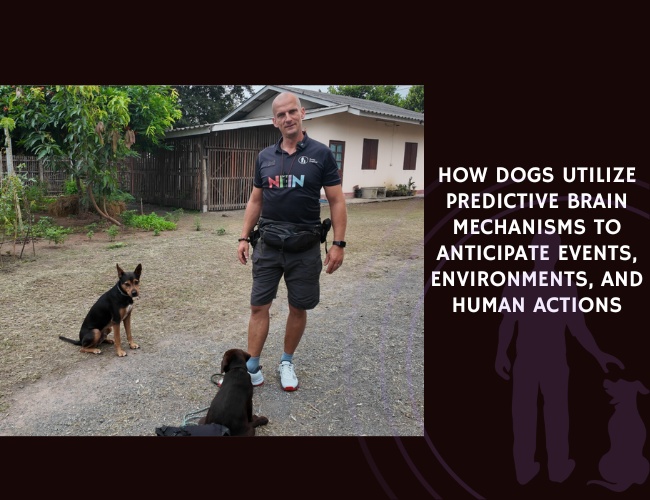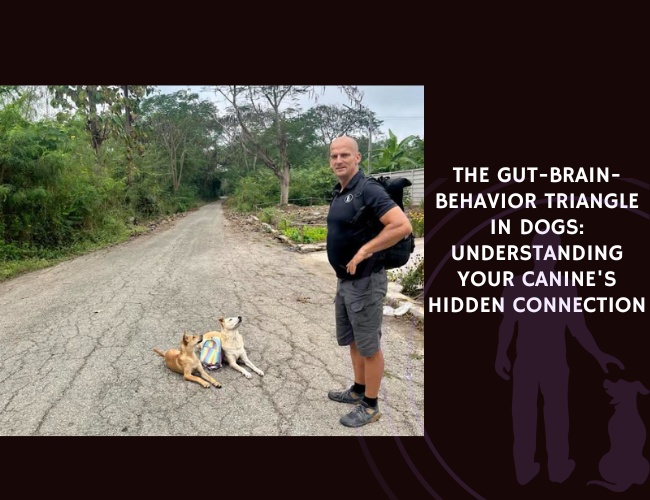Introduction to Environmental Influences on Dog Behavior
Overview of the Fundamental Differences Between Free-Range and Pet Dogs
The environments in which dogs grow and live have a crucial impact on their behaviors and skills. Free-range dogs, which include stray and feral canines, experience a markedly different lifestyle compared to pet dogs who live in the more controlled, predictable environments of human homes. These core environmental differences shape their behaviors, social structures, survival strategies, and even their psychological responses.
Free-range dogs navigate a world full of uncertainties, where finding food, shelter, and avoiding threats are daily challenges. Their social interactions generally occur with other dogs and fauna in their surroundings. Conversely, pet dogs are accustomed to regular feeding schedules, reliable shelter, and consistent human companionship, which significantly influences their behavioral development.
Impact of Environment on Behavioral Development
The environment in which a dog matures plays a foundational role in shaping its behavior. For example, the necessity for resourcefulness and independence is evident in free-range dogs, who often develop acute problem-solving skills and resilience due to their survival needs. These skills not only help them to find food but also navigate complex social interactions within their packs.
Pet dogs, however, rely heavily on their human caretakers. They exhibit behaviors that foster human-dog bonds, such as following commands, seeking attention, and showing affection. Their challenges revolve more around socialization and adapting to human environments. Obedience, trust, and social behavior adaptation are influenced heavily by human interaction. Without the same need for self-sufficiency, pet dogs often develop different coping and interaction mechanisms.
Significance of Understanding These Differences for Dog Training and Care
Recognizing the fundamental behavioral differences attributable to a dog’s environment is critical for trainers and pet owners alike. Understanding that free-range dogs have ingrained survival mechanisms highlights the necessity for patience and specialized training methods tailored to their heightened sense of independence and resourcefulness. A more rigorous approach might be required to build trust and to refine their skills towards human-oriented behavior.
For pet dogs, training can focus on harnessing their natural inclination towards forming strong human bonds. Training methods can capitalize on their dependency by reinforcing obedience and positive social behavior within the home environment. This tailored approach helps in shaping their reactions to new people, environments, and experiences in a manner conducive to domestic life.
Appreciating and adapting to these differences is fundamental in providing effective care and training. By taking into account the environmental influences that shape behavior, owners and trainers can optimize their approach to meet the emotional and physiological needs of their dogs, fostering happier and healthier canine companions.
Social Dynamics and Pack Behavior
Comparison of Social Structures in Free-Range vs. Pet Dog Environments
The social structures of free-range and pet dogs exhibit fundamental differences influenced by their respective environments. Free-range dogs, often living in semi-feral states, tend to form loose, adaptable packs where the hierarchy may shift based on resource availability and individual strength. Within these groups, dogs rely on their social ties for foraging, defense, and reproduction. This flexible structure facilitates survival in unpredictable conditions.
Pet dogs, on the other hand, primarily interact within a human-facilitated environment. Their “pack” often consists of human family members and other household pets, leading to a more static hierarchy dictated largely by the humans. Pet dogs may not need to engage in the same level of cooperative survival strategies as free-range dogs. Instead, their interactions are guided by house rules, training, and their role within the family unit.
Development of Social Skills and Hierarchical Understanding
The development of social skills and hierarchical understanding is greatly influenced by the nature of a dog’s social environment. Free-range dogs often learn through direct interactions and consequences in their immediate environment. They develop complex social skills by negotiating their position within the pack, understanding the importance of forming alliances, and competing or cooperating for resources. This natural exposure to varied interactions typically enhances their social problem-solving abilities and fosters an intuitive grasp of hierarchical structures.
Pet dogs, however, might receive less diverse social interactions. While training and human-led socialization can teach commands and increase obedience, it can sometimes lack the depth of natural social negotiations. In multi-dog households, pet dogs can still experience pack dynamics, albeit moderated by human intervention. Understanding and integrating these hierarchical cues become crucial to their behavior, but it is usually less dynamic compared to the constantly changing hierarchies of free-range packs.
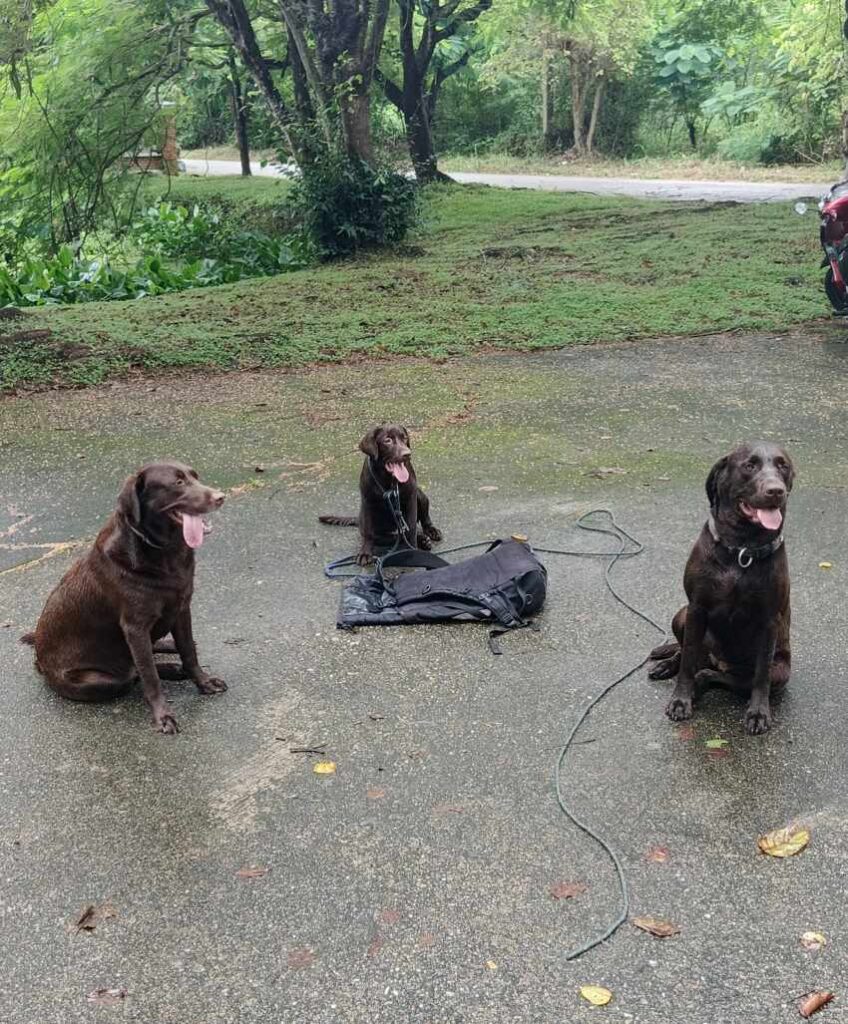
Influence of Human Interaction on Social Behavior
Human interaction plays a pivotal role in shaping the social behaviors of pet dogs. From an early age, pet dogs are influenced by the behaviors and expectations set by their owners. Positive reinforcement, training, and regular interaction with humans can lead to more predictable and sociable dogs. The human-dog bond nurtures traits such as loyalty, protectiveness, and an affinity for companionship.
For free-range dogs, human interaction is often more irregular and less foundational to their daily lives. These dogs may exhibit wariness or opportunistic behaviors towards humans, seen more as another variable in their environment rather than central figures. Some free-range dogs that experience consistent human interaction may develop a friendly disposition, but they still retain a degree of independence essential for survival.
Understanding these nuances aids in dog training and care by providing insight into how a dog’s environment and experiences shape their behavioral development. Recognizing the inherent differences in social needs and behaviors between free-range and pet dogs can help tailor more effective training and care protocols. This individualized approach promotes not only better behavioral outcomes but also an enhanced quality of life for each dog.
Recognizing these environmental and experiential differences is crucial for training and caregiving strategies tailored to each dog’s unique background. This individualized approach can foster more effective communication and a deeper bond between dogs and their caregivers, enriching their lives and promoting better behavioral outcomes.
Resource Acquisition and Survival Strategies
Differences in Food-Seeking Behaviors and Resource Management
Free-range and pet dogs exhibit markedly different food-seeking behaviors due to the varying nature of their environments. Free-range dogs, often left to their own devices, must actively seek out food. This typically involves foraging, scavenging, and hunting. They have to be resourceful and persistent, as their survival depends on their ability to locate and secure food. These dogs are adept at finding multiple food sources and managing their acquired resources efficiently to ensure their survival during food-scarce periods.
Pet dogs, on the other hand, have their nutrition directly provided by humans. Their food-seeking behavior is minimal and primarily involves begging or signaling hunger to their owners. The predictability and regularity of their meals mean pet dogs do not develop the same level of resource management skills as free-range dogs. The human-managed environment significantly shapes pet dogs’ food-related behaviors, reducing their need to persistently seek or save resources.
Development of Problem-Solving Skills in Different Environments
The need to solve problems to survive and thrive in their respective environments has a profound impact on the cognitive development of both free-range and pet dogs. Free-range dogs, facing constant challenges, develop robust problem-solving skills. The necessity to overcome barriers, navigate complex terrains, and outwit prey or competitors sharpens their cognitive abilities. Their brains are continually engaged in complex problem-solving activities, leading to advanced mental agility and adaptability.
Pet dogs develop problem-solving skills more through interactions with their human caregivers and structured play. Toys that dispense food, puzzles, and training exercises help stimulate their cognitive functions. However, the complexity and type of problems pet dogs encounter are often less demanding than those faced by free-range dogs. As a result, while pet dogs can become proficient in specific tasks, their problem-solving skills tend to be narrower in scope and primarily directed by human-led activities.
Impact of Resource Availability on Persistence and Adaptability
The availability of resources in free-range and pet dog environments heavily influences their persistence and adaptability. Free-range dogs often experience fluctuating resource availability, which requires them to be highly adaptable. Their persistence in seeking out food and water in the face of scarcity conditions them to be tenacious and resilient. This constant adaptation fosters a high level of mental and physical endurance, making them capable of handling unforeseen challenges with greater ease.
Pet dogs’ consistent access to resources, courtesy of their human caregivers, often results in lower levels of development in persistence and adaptability. They are less likely to face severe shortages or environmental extremes, leading to a comparatively lower drive to overcome difficulties. While this stable environment promotes a sense of security and well-being, it does not offer the same opportunities for developing adaptability and persistence. Thus, pet dogs may not exhibit the same level of resilience or resourcefulness as their free-range counterparts.
Understanding these differences in resource acquisition and survival strategies between free-range and pet dogs can help inform more tailored approaches to training and care. Considering each dog’s environmental background can enhance the effectiveness of training programs and enrich the caregiver-dog relationship.
Stress Response and Coping Mechanisms
Understanding the differences in stress response and coping mechanisms between free-range and pet dogs is key to providing effective care and training. The environments in which these dogs live heavily influence how they manage stress and develop coping strategies.
Environmental Stressors Unique to Each Group
Free-range dogs are subject to an array of environmental stressors that are not typically encountered by pet dogs. These include:
- Food Scarcity: The need to forage or hunt for food can create persistent stress.
- Predatory Threats: Free-range dogs must constantly be aware of predators and other dangers.
- Weather Conditions: Exposure to harsh weather without the shelter and comfort provided for pet dogs.
Pet dogs, on the other hand, experience a different set of stressors, primarily due to their interactions with humans and domesticated living conditions:
- Separation Anxiety: This is a common issue where dogs become stressed when separated from their primary caregiver.
- Lack of Mental Stimulation: Pet dogs may experience boredom and frustration due to lack of sufficient mental and physical engagement.
- Noise Sensitivity: Urban sounds and household noises can become significant stressors.
Development of Different Coping Strategies
Free-range dogs develop coping strategies that are adaptive to their constantly changing and often unpredictable environments:
- Resourcefulness: Finding or creating shelter, seeking food, and avoiding threats.
- Independence: Reliance on oneself or the pack without human intervention.
Pet dogs develop coping mechanisms shaped by their interactions with humans and a more predictable environment:
- Human-Driven Comfort: Seeking comfort and security through human interaction and familiar routines.
- Environmental Conditioning: Desensitization to household noises and urban sounds through gradual exposure.
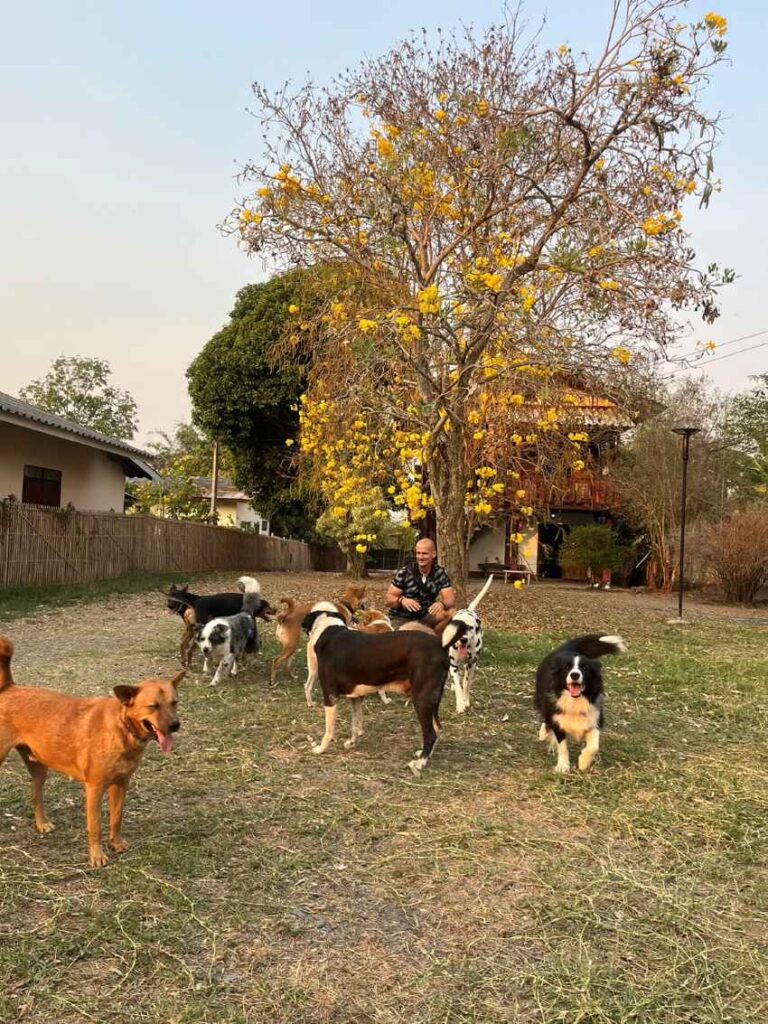
Comparison of Anxiety Patterns and Stress Management
The differences in environmental stressors between the two groups lead to marked differences in their anxiety patterns and stress management.
- Anxiety in Free-Range Dogs: While free-range dogs encounter significant stressors, their freedom to choose behaviors to mitigate these stresses can result in less pronounced anxiety patterns. Their persistence and adaptability equip them to manage stress effectively.
- Anxiety in Pet Dogs: Pet dogs may exhibit more apparent anxiety due to the constraints of their environment. Separation anxiety, noise sensitivity, and lack of stimulation can result in behaviors such as excessive barking, destructive chewing, or other manifestations of anxiety.
Understanding these differences is critical for dog training and care. It allows us to tailor approaches that consider the environmental background of each dog. Providing enrichment activities that simulate challenges faced by free-range dogs can enhance the mental agility and stress management abilities of pet dogs. Furthermore, recognizing the unique vulnerabilities of pet dogs and addressing them with targeted strategies can help mitigate anxiety and improve their overall well-being.
Problem-Solving and Persistence
Analysis of Problem-Solving Abilities in Both Groups
When comparing the problem-solving abilities of free-range and pet dogs, it’s essential to consider the divergent environments that shape these capabilities. Free-range dogs, living in conditions where survival is contingent on their ability to navigate various challenges, naturally develop advanced problem-solving skills. They frequently encounter obstacles such as finding food, evading predators, and navigating unfamiliar territories. These experiences foster an adaptive mindset and enhance cognitive functions.
Pet dogs, on the other hand, typically live in controlled environments where many challenges are mitigated by human intervention. Their problem-solving experiences largely stem from activities provided by their caregivers, such as interactive toys or training exercises. While these activities do stimulate cognitive functions, they do not usually replicate the complexity or frequency of challenges faced by free-range dogs. Consequently, pet dogs’ problem-solving skills can be less honed compared to their free-range counterparts.
Role of Environmental Challenges in Developing Persistence
Persistence, the ability to remain determined in the face of obstacles, is richly influenced by environmental factors. Free-range dogs are often confronted with situations that require sustained effort and creativity to overcome. This can include finding scarce food resources, enduring adverse weather conditions, or navigating human-made barriers. The necessity to persist through such challenging scenarios naturally fortifies their resilience and problem-solving persistence.
Conversely, pet dogs are less frequently subjected to such high-stakes scenarios. Their environment, usually tailored for safety and comfort, seldom demands the same level of persistence. Humans provide for their basic needs, reducing the need to endure or overcome persistent challenges. Training routines and enrichment activities designed by caregivers do contribute to developing persistence, but these are generally less intense and less frequent than those encountered by free-range dogs.
Differences in Risk-Taking and Exploratory Behaviors
Environmental influences also yield notable differences in risk-taking and exploratory behaviors between free-range and pet dogs. Free-range dogs, driven by the constant demand to secure resources and navigate dynamic environments, exhibit a higher propensity for taking risks and exploring unknown areas. This behavior is essential for their survival as it increases their chances of finding food, shelter, and other resources.
Pet dogs, however, often show reduced inclination toward risk-taking and exploration. Their environments are frequently structured to minimize potential dangers, and their meals and care are reliably provided. The reduced necessity to explore or take risks means they often exhibit more cautious behaviors. Structured play and controlled exploration exercises under human supervision can stimulate their exploratory instincts, but these situations lack the unpredictability and necessity that drive the behaviors seen in free-range dogs.
Understanding these differences in problem-solving and persistence between free-range and pet dogs is crucial for tailoring training and enrichment activities. By implementing challenges that mimic natural scenarios, caregivers can enhance the cognitive and adaptive abilities of pet dogs, working towards a balanced and stimulating environment.
As we transition into the practical applications and recommendations, these insights will shape strategies aimed at optimizing the behavior and well-being of pet dogs through personalized enrichment activities.
Practical Applications and Recommendations
Training Considerations Based on Environmental Background
Effective dog training requires an understanding of how different environments shape canine behaviors. Recognizing the unique backgrounds of free-range and pet dogs will help in tailoring training methods to suit each dog’s specific needs and experiences.
Pet dogs, being accustomed to human interaction and existing within structured environments, benefit greatly from positive reinforcement and consistent routines. Free-range dogs, on the other hand, have developed problem-solving skills and independence, requiring a more nuanced approach that acknowledges their self-sufficiency. Trainers should focus on creating challenges that stimulate their keen problem-solving abilities while maintaining a secure and supportive environment.

Strategies for Enhancing Adaptability in Pet Dogs
Enhancing adaptability in pet dogs is vital for well-rounded behavior and improved coping mechanisms. One effective approach is exposure therapy – gradually introducing new scenarios, sounds, and experiences to build confidence and reduce anxiety. Utilizing the rich problem-solving skills seen in free-range dogs, owners can incorporate puzzle toys and games that encourage mental stimulation and active engagement.
Adaptive variation in training routines is also key, as it prevents monotony and stimulates the dog’s cognitive faculties. For instance, using variations in routes during walks, incorporating different commands, and interactive play promotes adaptability.
Implementation of Enrichment Activities that Simulate Natural Challenges
Simulating natural challenges through enrichment activities is instrumental in fostering both mental and physical stimulation for pet dogs. Drawing inspiration from the environmental dynamics experienced by free-range dogs, owners and trainers can introduce elements that mimic real-life scenarios.
Some practical enrichment activities include:
- Foraging Toys: These mimic the food-seeking behavior in free-range dogs, encouraging pet dogs to use their instincts and problem-solving skills.
- Obstacle Courses: Setting up small obstacle courses using household items can emulate the physical challenges free-range dogs face, enhancing agility and coordination.
- Scent Trails: Using scent trails created with treats or specific scents can engage a dog’s remarkable sense of smell, providing both physical exercise and mental stimulation.
- Interactive Play: Games like hide and seek, and search & retrieve help simulate the interactive and dynamic nature of a free-range dog’s environment, promoting physical fitness and cognitive engagement.
Implementing these enrichment strategies not only bridges the gap between free-range and pet dogs but also ensures that pet dogs develop resilience, problem-solving abilities, and adaptability.
Understanding and addressing the unique environmental backgrounds of dogs enables tailored training and enrichment activities that nurture well-adapted, balanced, and happy pets.
In the ensuing sections, we will delve further into the role environmental challenges play in developing persistence and explore additional strategies for maintaining a stimulating environment for dogs.

